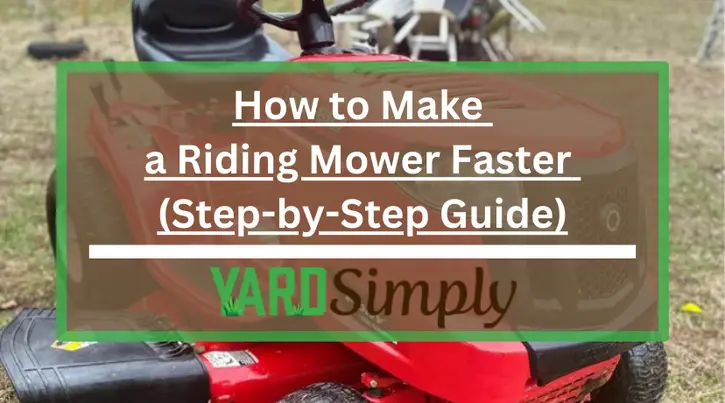Last weekend, as I watched my neighbor zip across his lawn on a riding mower that seemed to rival a sports car in speed, I couldn’t help but wonder about the modifications he’d made.
As a professional with a keen interest in mechanics and DIY projects, I’ve learned that increasing the speed of a riding mower involves a blend of art and science.
It’s not just about pushing the machine to its limits, but also about understanding the intricate balance between power, stability, and safety.
In this guide, I’ll share some insider tips and tricks on how to safely tweak your mower for better performance.
However, before we get into the nitty-gritty of gear ratios and engine tuning, it’s crucial to consider why you’re pursuing this upgrade and how it might affect the longevity and functionality of your machine.
Join me as we explore the potential and the pitfalls of turning your dependable lawn companion into a swifter, more efficient grass-cutting machine.
Quick Summary
- To make a riding mower faster, it’s important to understand its mechanics and make modifications such as tuning the engine, adjusting the governor, and upgrading components like the air filter and exhaust.
- Safety measures, including wearing protective gear and understanding the mower’s limits, are crucial to prevent injuries during the modification process.
- Regular maintenance can improve riding mower speeds by up to 20%.
- In my opinion, the effort to modify a riding mower is well worth the increased performance and efficiency.
Step by Step: Make a Riding mower faster
- Upgrade the Engine: Increase the engine’s power by upgrading components like the air filter, exhaust, and spark plugs. You can also consider advanced engine tuning, such as adjusting the carburetor and the ignition timing.
- Adjust the Governor: The governor controls the maximum speed of the engine. Adjusting or removing the governor can increase the mower’s speed, but it can also put additional strain on the engine.
- Modify the Pulleys: Change the pulley sizes on your mower. A smaller pulley on the engine or a larger one on the transmission can increase speed. However, this can also affect the mower’s torque and overall performance.
- Optimize Gear Ratios: Adjusting the gear ratios can increase speed. You need to find a balance that offers enough torque for your landscape while maximizing speed.
- Reduce Weight: Remove non-essential parts to lighten the mower. A lighter mower can accelerate faster and achieve higher speeds.
- Improve Aerodynamics: Make modifications to reduce drag, such as streamlining the body of the mower.
- Upgrade Suspension and Tires: Better suspension can handle higher speeds more safely. High-performance tires can improve grip and stability.
Understanding Your Riding Mower
Before we can speed up our riding mower, I need to get a handle on how it works.
I’ll look at the basic mechanics that drive its performance and identify what factors might be holding back its speed.
Understanding these elements is crucial if I’m going to make any successful modifications.
Basics of Riding Mower Mechanics
Understanding the basic mechanics of your riding mower is crucial if you’re aiming to make it operate at higher speeds.
I’ve learned that engine lubrication is a must to reduce friction and prevent overheating.
The clutch operation is also vital; it must engage and disengage smoothly for quick responses.
I keep an eye on belt health, ensuring they’re not worn or loose, which could lead to power loss or slippage.
A well-maintained differential gear is key for sharp turns and consistent speed on various terrains.
Lastly, spark plug function can’t be overlooked; a clean, correctly gapped spark plug ensures efficient fuel combustion.
Mastering these elements has laid the groundwork for my mower’s enhanced performance.
Factors Affecting Mower Speed
Diving into what makes a riding lawn mower go faster, several factors come into play, from engine power to the aerodynamics of the machine itself. Here’s what I’ve learned significantly impacts how fast my mower can go:
- Engine Size: Larger engines generally mean more power, which can translate into higher speeds.
- Tire Pressure: Properly inflated tires reduce rolling resistance and can help the mower move faster.
- Transmission Type: Hydrostatic transmissions may offer smoother speed transitions, whereas manual ones may afford more control.
- Grass Conditions: Mowing over wet or thick grass can slow the mower down, while dry, thin grass allows for quicker movement.
I also can’t overlook the importance of lubrication efficiency. A well-lubricated machine means less friction and better performance, potentially leading to a faster ride.
Preparatory Steps
Before I get my hands dirty, I need to gather the right tools and materials to ensure a smooth upgrade process.
It’s also crucial that I take the proper safety measures to prevent any injuries while working on my riding mower.
These initial steps will pave the way for a successful and efficient modification.
Tools and Materials Needed
To make your racing mower faster, you’ll need a set of tools and materials that are essential for the modification process. Before I dive into the nuts and bolts, I ensure I’m equipped with the right gear to tweak:
- Engine Compatibility Tools: These help me ascertain whether the engine can handle higher speeds without compromising safety.
- Gear Ratio Kit: It’s crucial for adjusting gear ratios to optimize speed and ensure efficient power transfer.
- Torque Wrench: For precise torque analysis, so I don’t over-tighten and strain the mower’s components.
- Lubricants and Clutch Adjusters: The right lubricant selection is key to smooth operation, while clutch adjustments are necessary to manage the power delivery effectively.
Armed with these, I’m set to rev up my mower’s performance responsibly.
Safety Measures
I always prioritize safety in my lawn care practices. This means that I take several precautions before making any modifications to increase the speed of my mower.
First, I make sure to don protective gear and double-check the stability of the mower. These steps ensure that I am protected and that the equipment is in good condition before proceeding with any adjustments.
Another important aspect of safety is rider training. Before even considering tweaking the engine or adjusting the governor, I make sure that I have completed proper training to handle increased velocities.
This training includes learning how to perform emergency stops and maneuver swiftly in case of any unforeseen issues. By having these skills, I can confidently operate the mower at higher speeds while still ensuring my safety.
Learn More: Zero Turn Mower Accidents: Possible Risks
Speed Enhancement Methods
Now that we’ve prepped our riding mower, it’s time to crank up the speed.
I’ll walk you through tweaking the engine, swapping out parts for performance, and shedding some weight to get that mower booking.
We’ll even touch on how making the machine more aerodynamic can cut through the air faster.
Engine Tuning
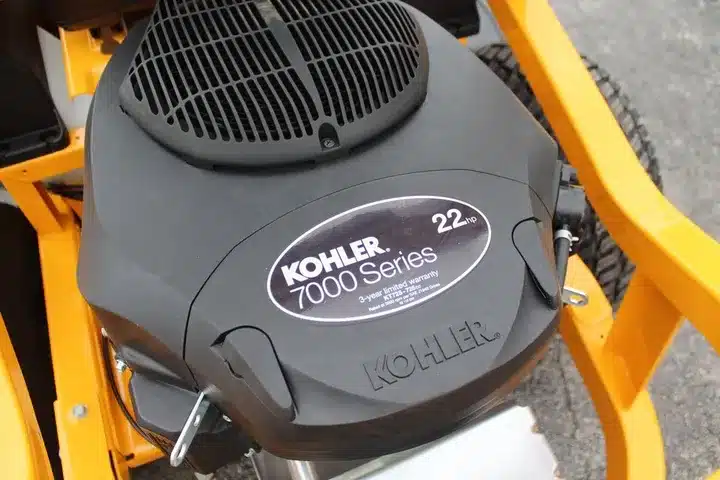
Engine tuning stands as a pivotal method for increasing the speed of a riding mower, focusing on optimizing the machine’s performance parameters.
Here’s how I go about enhancing the engine:
- Engine Modifications for Airflow and Fuel Delivery: The first step in tuning is tweaking the engine to improve airflow and fuel delivery. This can significantly increase horsepower and torque, essential for a faster mower. Enhancements might include upgrading the intake system, modifying the carburetor, or installing high-performance parts that allow the engine to breathe and fuel more efficiently.
- Advanced Engine Tuning Techniques: Beyond the basic tweaks, advanced engine tuning can further enhance mower speed. This involves fine-tuning carburetor settings to optimize the air-fuel mixture, ensuring the engine runs at peak efficiency. Adjusting ignition timing is also critical; setting the spark plugs to fire at the ideal moment can enhance the engine’s response to the throttle. These adjustments require a detailed understanding of the engine’s workings and may involve specialized equipment.
- Installation of Performance Chips: Adding a performance chip can recalibrate the engine’s control unit, optimizing it for speed and efficiency. This electronic modification adjusts various parameters like fuel injection and ignition timing, offering a noticeable improvement in performance.
- Utilizing High-Octane Fuel: The use of higher-octane fuel can complement these modifications. High-octane fuel is less prone to knocking, which is particularly important if you’ve increased the engine’s compression ratio for more power. This helps in maintaining the integrity of the speed gains achieved through the modifications.
- Ignition Timing Adjustment: Proper ignition timing is key to maximizing engine performance. Adjusting the timing ensures that the spark plugs fire at the most effective moment, providing a more immediate and powerful response when you accelerate.
Upgrading Components
Having optimized the engine’s performance, we’ll next focus on upgrading various components to further enhance the riding mower’s speed.
I’ll ensure engine compatibility with any new parts I add, as mismatched components can lead to inefficiency or damage.
When selecting aftermarket parts, like a high-flow cooling system, I’ll check if they’re designed for my mower’s engine to prevent overheating at higher speeds.
I’ll also examine torque specifications, as they’re crucial for transmitting power without overburdening the engine.
I’m considering a transmission swap too; some transmission types offer better speed and acceleration. Hydrostatic transmissions, for example, can provide smoother and more responsive control.
Weight Reduction
To further boost my riding mower’s speed, I’ll strip unnecessary weight, recognizing that a lighter mower can accelerate more quickly and achieve higher engine speeds.
Here’s how I plan to shed those extra pounds:
- Material Choice: I’ll swap out heavy parts for lighter materials, like aluminum or composite plastics, wherever possible.
- Component Removal: Any non-essential parts that aren’t critical to the mower’s operation will be taken off to save weight.
- Chassis Lightening: I’ll look into options for reducing the thickness of the mower’s body without compromising its structural integrity.
- Driver Weight: I’ll also consider my own impact on performance, aiming to minimize the load the mower has to carry.
Aerodynamic Improvements
Reducing the drag coefficient is crucial. This means focusing on the mower’s body shape, aiming to make it as sleek as possible.
Reducing wind resistance by lowering the frontal area that faces the wind. It’s not just about a slim profile; Also smoothing out any edges that can catch the air.
I’m considering ground effects too. By adding components close to the ground, I can manage the airflow underneath the mower to minimize drag further.
Every little change I make to improve airflow can add up, shaving off seconds from my lap times or extending my top speed on the straightaways.
Suspension and Handling Improvements
Upgrading suspension and handling is essential for safety and control at higher speeds. Improved suspension systems can absorb shocks better, providing a smoother ride, especially in uneven terrains.
This can involve replacing stock suspension components with higher performance ones. Additionally, enhancing the mower’s handling through better steering systems or stabilizers can increase maneuverability and stability at high speeds.
These upgrades are particularly important for maintaining control and safety, preventing accidents that can arise from increased speed capabilities.
High-Performance Tires and Alignment
High-performance tires specifically designed for lawn mowers at high speeds can greatly impact the performance. These tires are typically made of superior materials offering better grip and durability, essential for higher speed operations.
Additionally, proper tire alignment is critical for optimal performance. Misaligned tires can cause resistance, reducing speed and efficiency.
Regularly checking and maintaining tire pressure, alignment, and condition ensures the mower operates at its best. It’s also crucial to choose tires suitable for your specific terrain to prevent slippage and maintain control.
In-depth Understanding of Gear Ratios
Optimizing gear ratios is pivotal for enhancing the speed of a riding mower. Gear ratios determine the balance between speed and torque, crucial for the mower’s efficiency.
To optimize, you need to understand the relationship between the drive (connected to the engine) and driven (connected to the wheels) pulleys. A smaller drive pulley combined with a larger driven pulley increases speed but decreases torque.
This setup is ideal for flat terrains where less power but more speed is needed. In contrast, a larger drive pulley and a smaller driven pulley enhance torque, beneficial for hilly terrains.
It’s crucial to find a balance that offers enough torque for your landscape while maximizing speed.
Step-by-Step Modification Guide
I’m going to walk you through a practical guide to ramp up your riding mower’s speed, focusing on the essential modifications.
We’ll start by tweaking the governor for higher RPMs, then move on to improving air flow and fuel delivery.
Lastly, I’ll show you how to adjust the pulleys and maintain the tires to ensure your mower isn’t only faster but also safe to operate.
Adjust the Governor
How can you unleash the full potential of your riding mower’s engine? Adjusting the governor is a critical step. But before I proceed, I consider the governor types, speed risks, performance limitations, warranty concerns, and legal implications.
Here’s how I tackle this task:
- Identify the Governor Type: Mechanical or electronic, each type requires a different approach.
- Understand the Risks: Increasing speed can lead to instability and wear; I’m aware and accept the potential dangers.
- Consult Warranty and Legal Restrictions: Tampering with the governor may void my warranty or violate local regulations.
- Proceed with Caution: If I decide to proceed, I adjust the governor gradually, monitoring the mower’s response to ensure I don’t push it beyond safe operating limits.
Upgrade the Air Filter and Exhaust
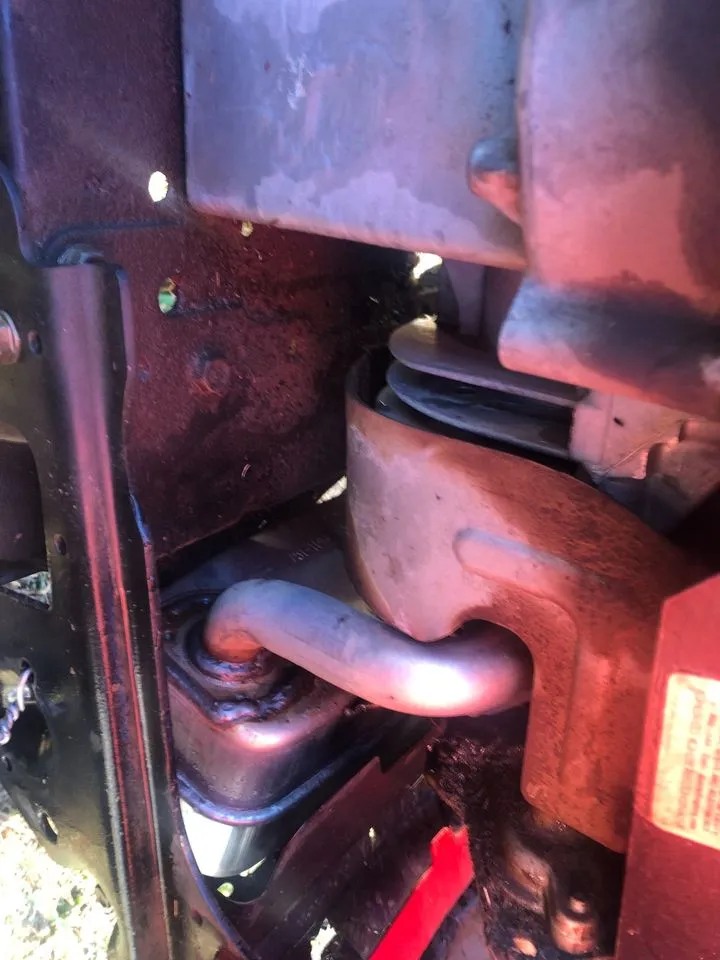
Having adjusted the governor, I’ll now enhance the mower’s performance further by upgrading the air filter and exhaust system.
First, I need to ensure engine compatibility; not all filters and exhausts fit every model. I’ll select a high-flow air filter, which comes in different types—standard, pleated, or oiled.
Each has its pros and cons, but they all aim to allow more air into the engine, thereby improving combustion.
Next, I’ll look into aftermarket exhaust options that can reduce backpressure, thus increasing power output.
However, I’m mindful of performance risks like overheating or undue engine strain. Also, I’ll check local exhaust regulations to ensure my modifications remain legal.
With the right balance, these upgrades can significantly boost my mower’s speed and efficiency.
Modify the Pulleys
To further quicken my riding mower, I’ll start by modifying the pulley system, a process which involves replacing the existing pulleys with ones of different sizes to alter the gear ratio. Here’s my step-by-step guide:
- Assess Pulley Ratios: I’ll examine the current pulley setup to determine the optimal size increase for the engine pulley and decrease for the transmission pulley.
- Choose Belt Selection: I’ll select a belt that can handle the new pulley sizes without slipping or wearing excessively.
- Consider Transmission Risks: I’m aware that these changes can strain the transmission, so I’ll proceed with caution to avoid costly damage.
- Select Pulley Materials: I’ll opt for pulleys made of durable materials to withstand the increased speed, and I may need clutch modifications to ensure the mower can handle the power shift.
Enhance Fuel Delivery
After addressing the mower’s pulley system, I’ll now focus on upgrading the fuel delivery to ensure the engine receives the optimal mixture of air and fuel for better performance.
First, I’m considering the fuel types my mower can handle. Higher octane fuels can sometimes offer better combustion, so I’ll be checking the manufacturer’s recommendations before switching.
Next, I’m tackling the carburetor adjustments. A well-tuned carburetor can significantly improve throttle response. I’ll carefully tweak the fuel mixture screw to enrich the mixture just enough to enhance power without causing the engine to run rough.
I’m also exploring fuel additives that could clean and lubricate the injection systems, ensuring a smoother flow of fuel.
Lastly, an upgraded fuel injection system, if applicable, could provide a more precise fuel delivery, further improving throttle response and overall speed.
Check and Replace Tires
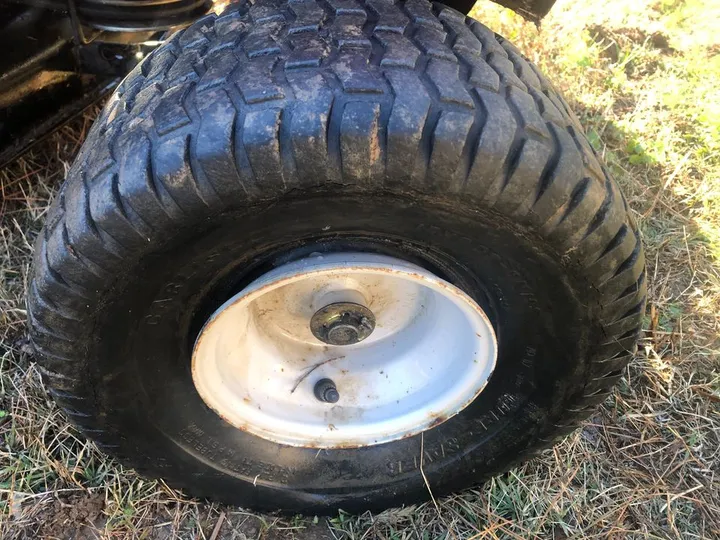
Inspecting the tires is the next critical step in boosting your riding mower’s speed, ensuring they’re in top condition for improved traction and reduced rolling resistance. Here’s what I focus on:
- Tire Selection: I choose tires that complement my mower’s capabilities and the terrain I’ll be traversing. Opting for the right size and type can make a significant difference.
- Pressure Check: Regularly checking the tire pressure keeps them at optimal performance levels and helps with speed consistency.
- Tread Patterns: I assess the tread patterns for wear and tear. Well-defined treads are essential for grip and efficient movement.
- Puncture Repair and Seasonal Maintenance: I’m always prepared to fix punctures to avoid downtime. Plus, I perform seasonal maintenance to ensure my tires don’t degrade when not in use.
Reduce Weight
Having checked and replaced the tires for optimal performance, I’ll now focus on shedding unnecessary weight from my riding mower to further increase its speed.
I’ll start by removing any non-essential parts that don’t contribute to the mower’s core functions. This includes aftermarket accessories and cosmetic features that may look nice but add extra pounds.
Next, I’ll conduct a thorough engine balance and torque analysis. By ensuring the engine operates efficiently, I reduce the strain and improve the power-to-weight ratio.
I’ll also check the drive belt condition, making sure it’s in top shape, as a worn belt can add unnecessary drag.
Additionally, I’ll fine-tune the clutch adjustment for better power delivery and optimize the brakes to ensure they engage and disengage cleanly, without adding resistance when they’re not in use. Every ounce saved contributes to a swifter ride.
Related Articles:
Test the Mower
Before hitting the throttle on my revamped riding mower, I’ll conduct a series of tests to ensure the modifications have effectively enhanced its speed and performance.
It’s not just about prepping for mower races; it’s about hitting those speed benchmarks with ease. Here’s the rundown:
- Performance Metrics: I’ll measure the time it takes to cover a set distance, comparing it to the pre-modification times.
- Efficiency Factors: I’ll check fuel consumption to ensure that my customization options haven’t negatively impacted efficiency.
- Speed Benchmarks: I’ll clock the top speed to see if I’ve hit my target and if it aligns with safe operating speeds.
- Customization Options: Finally, I’ll test any additional features to confirm they’re functioning correctly without hindering speed.
Fine-Tune Adjustments
After testing my riding mower’s performance, I’ll now meticulously adjust the engine’s settings to achieve the optimal balance of speed and efficiency.
First, I’ll ensure engine compatibility with any new parts I’ve added. This sometimes means tweaking the air-fuel mixture for a cleaner burn or adjusting the carburetor for a better throttle response.
Next, I’ll consult the manufacturer’s torque specifications to re-torque all bolts, ensuring everything’s tight and right.
I can’t overlook the importance of using the correct lubricant types either; the right oil can reduce friction and help the engine run smoother.
Then, I’ll fine-tune the idle adjustment for a steady engine run without stalling. Lastly, I’m tweaking the clutch engagement to respond quicker. With these adjustments, my mower’s all set to hit higher speeds more reliably.
Testing and Safety Checks
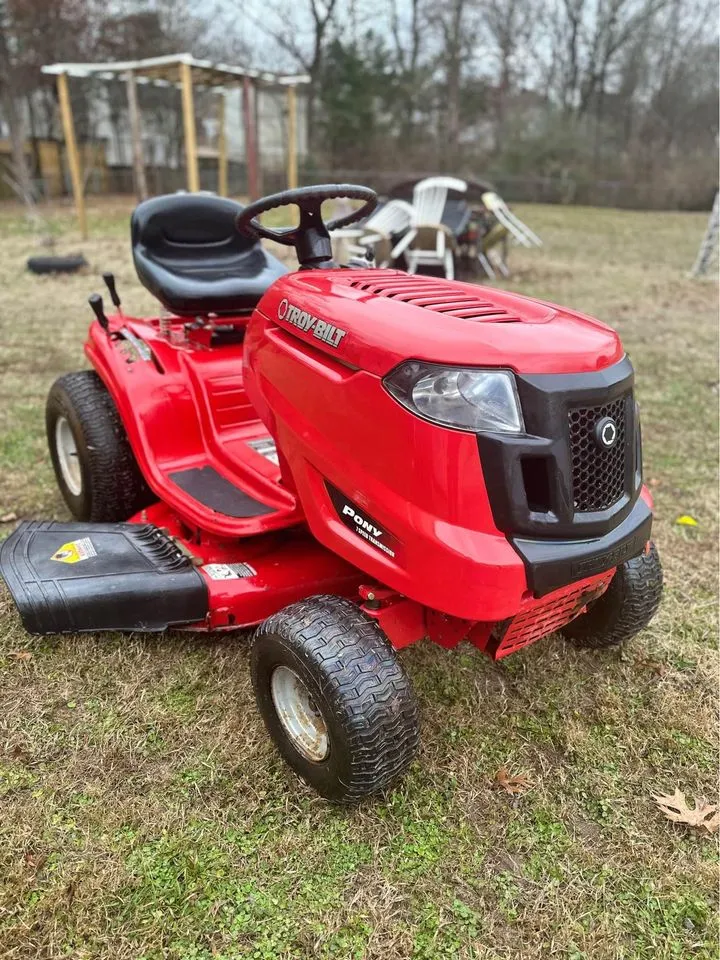
Now that I’ve tweaked my riding mower for speed, it’s crucial to ensure everything works as intended.
I’ll be going over the testing procedures to catch any issues before they lead to mishaps.
It’s also key to troubleshoot common problems to keep my mower running safely and efficiently.
Testing Procedures
I ensure the mower’s functionality and safety by rigorously testing it following any modifications to increase its speed. Here’s my step-by-step process:
- Mower Diagnostics: I begin with a thorough diagnostic check to assess the mower’s condition, ensuring all systems operate within their normal parameters.
- Speed Trials: Next, I perform multiple speed trials to measure the mower’s acceleration and top speed, carefully noting any changes from the baseline.
- Performance Metrics: I collect data on various performance metrics, including responsiveness and handling during maneuvers.
- Benchmark Analysis and Control Testing: Finally, I compare the results to pre-modification benchmarks and conduct control testing to validate the upgrades’ effectiveness, making sure the mower remains safe and controllable at higher speeds.
Troubleshooting Common Issues
Having established the mower’s enhanced performance, let’s address potential issues that may arise during testing and the necessary safety checks.
It’s common to encounter engine overheating if I’ve pushed the mower’s limits. I’ll keep an eye on the temperature gauge and ensure proper airflow around the engine.
Spark plug issues can also crop up, causing misfires or poor engine performance. I’ll inspect and replace them if they’re worn or fouled.
I’ve noticed belt slippage can lead to a loss of speed and efficiency, so I’ll check the tension and condition of all belts.
Fuel line blockages are another culprit I’ll be wary of; ensuring the fuel lines are clean is crucial for consistent performance.
Lastly, I’ll troubleshoot any electrical malfunctions by carefully examining wires and connections for corrosion or damage.
Regular Maintenance and Checks
Regular maintenance is the cornerstone of not only keeping your riding mower in optimal condition but also a key factor in making it faster. I’ve learned that a well-maintained machine performs better and zips across the lawn with less resistance.
Here’s how I ensure my mower is ready to go:
- Engine Oil Check: I regularly check the engine oil level and change it according to the manufacturer’s recommendations. Clean oil ensures smooth engine operation.
- Tire Pressure Adjustment: I maintain the correct tire pressure for even weight distribution and reduced rolling resistance, which can give a slight speed boost.
- Spark Plug Maintenance: A clean, properly gapped spark plug is crucial for efficient fuel combustion. I replace it if it’s worn or fouled, which helps in maintaining engine power.
- Blade Sharpening and Balance: Sharp blades mean efficient cutting, which translates to less drag on the engine. I also make sure they’re balanced for a smooth ride.
I don’t forget to check the battery health, as a weak battery can lead to poor performance. By following these steps, I’ve noticed an improvement not just in my mower’s speed but also in its overall performance.
Our Verdict
After delving into the intricate world of riding mower modifications, I’ve come to appreciate the delicate balance between speed and safety.
Personally, the journey of tweaking my mower, from adjusting the governor to optimizing the gear ratios, has been both challenging and rewarding.
The thrill of zipping across my lawn at increased speeds is undeniable, but it’s matched by the satisfaction of knowing I’ve done it safely and responsibly.
While enhancing my mower’s performance, I’ve learned the importance of regular maintenance and the impact of each modification on the machine’s longevity.
For fellow DIY enthusiasts, embarking on this adventure offers not just a faster mower, but a deeper understanding of the mechanics behind it.
Just remember, with great speed comes great responsibility!
Frequently Asked Questions
What are the legal implications of modifying a riding mower for increased speed?
I’m considering the legalities of modifying a vehicle for speed. Safety concerns, legal boundaries, modification permits, local ordinances, and speed regulations all play a part in what I can legally do.
Can making my riding mower faster void the warranty or affect my insurance coverage?
Absolutely, speeding up my mower could void its warranty and impact my insurance coverage. I’d consult the warranty clauses, check insurance policies, and discuss any modifications with the dealer, always noting safety precautions.
How does terrain affect the speed modifications I plan to make to my riding mower?
I’m analyzing the terrain to adjust the slope and weight distribution for optimal traction. This ensures my gear ratios are tuned correctly for the land’s contours, making my ride smoother and more efficient.
Are there any environmental considerations I should be aware of when altering the performance of my riding mower?
I’m considering the environment before tweaking my mower. I’ll minimize engine emissions, reduce noise pollution, cut fuel consumption, avoid wildlife disturbance, and lessen my ecological footprint to protect our surroundings.
What is the impact of speed enhancement on the longevity and resale value of my riding mower?
Boosting my mower’s speed can increase engine wear, raise maintenance costs, and add stress to components. It may also affect operational safety and lower resale value, especially with frequent use.

